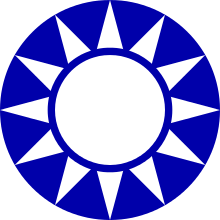1st National Congress of Kuomintang
The 1st National Congress of Kuomintang (Chinese: 中國國民黨第一次全國代表大会) was the first national congress of Kuomintang, held on 20–30 January 1924 at Guangzhou, Guangdong, Republic of China.[1]

Results
During this first congress, Kuomintang's reorganization process to become Kuomintang of China (Chinese: 中國國民黨) in 1919 from the previous Chinese Revolutionary Party was formally completed.[2] A policy declaration was also drafted to fight against imperialism and feudalism, determining three policies of alliance with Soviet Union and alliance with the Communist Party of China.[3] This first congress eventually led to the reunification of China four years later after the Northern Expedition.[4]
[5] As time progressed, the Chinese Kuomintang (KMT) lost its grip in China and after its defeat on the Chinese mainland, the party retreat to Taiwan. From 1950 to 1952, the KMT underwent a thorough organizational restructuring. The result was a renewal of its Leninist origins from the previous reorganization in 1924. [6] This came from the help of the Kuomintang Central Reform Committee. The Kuomintang Committee created a variety of direct or indirect controls over the government and society that gave it unquestioned dominance. This eventually led to the party interacting closely with the people on Taiwan as a result of the party recruitment and the implementation of local-level political reforms, two salient agendas that had never taken place in the mainland.
The KMT Today
[7] On the first electoral defeat of the age-old Kuomintang (KMT) in the year 2000, many predicted its disintegration. However, as the 2004 election unfolded, many forecast its triumphant return. The party pursued a reform strategy before forging a pact with like-minded parties, and reestablished its leadership among the alliance of political opposition parties. The party itself however, is still going through an identity crisis and is struggling to maintain a foothold in the political format of China.
See also
References
- "Kuomintang News Network". Kmt.org.tw. 1991-05-20. Archived from the original on 2014-07-09. Retrieved 2014-05-11.
- "Kuomintang News Network". Kmt.org.tw. Retrieved 2014-05-11.
- "Jan 20—30,1924: Chinese Kuomintang holds its first National Congress". Chinadaily.com.cn. Retrieved 2014-05-11.
- "Kuomintang 10th Congress and its mission of national recovery". Archived from the original on 2014-05-12. Retrieved 2013-11-08.
- a. Dickson, B. J. (1993). The Lessons of Defeat: The Reorganization of the Kuomintang on Taiwan, 1950–52. The China Quarterly, 133, 56. Retrieved November 20, 2017, from https://www.cambridge.org/core/journals/china-quarterly/article/lessons-of-defeat-the-reorganization-of-the-kuomintang-on-taiwan-195052/B2258B8ECBCC4A32135B858C5128E2C0
- b. Myers, R. H. (2009). Toward an Enlightened Authoritarian Polity: the Kuomintang Central Reform Committee on Taiwan, 1950-1952. Journal of Contemporary China, 18(59), 185-199. Retrieved November 21, 2017, from http://www.tandfonline.com/doi/abs/10.1080/10670560802575945
- c. Cheng, T. (2006). Strategizing Party Adaptation. Party Politics, 12(3), 367-394. Retrieved November 22, 2017, from http://journals.sagepub.com/doi/10.1177/1354068806063086
